Effect of Immobilization of Phenolic Antioxidant on Thermo-Oxidative Stability and Aging of Poly(1-trimethylsilyl-1-propyne) in View of Membrane Application
Abstract
:1. Introduction
2. Materials and Methods
2.1. Materials
2.2. PTMSP Synthesis and Characterization
2.2.1. Synthesis
2.2.2. Intrinsic Viscosity
2.2.3. 13C NMR Spectroscopy
2.3. Preparation and Characterization of Films and Membranes
2.3.1. Preparation of PTMSP Isotropic Films
2.3.2. TFCM Formation
2.3.3. Thermal Treatment of PTMSP Isotropic Films
2.3.4. Film Density Determination
2.3.5. Thermogravimetric Analysis
2.3.6. Wide-Angle X-ray Diffraction (WAXD)
2.3.7. Gas Transport Properties Determination
Determination of Gas Permeability for PTMSP-Based Isotropic Films Prepared by Method 1
Determination of Gas Permeability for Isotropic Films Prepared by Method 2 and Gas Permeances of TFCMs
3. Results and Discussion
3.1. Gas Transport Properties of Isotropic Films
3.2. Thermal Stability and Aging of Annealed PTMSP Isotropic Films
3.3. Gas Transport and Structural Changes in Heat-Treated PTMSP Films
3.4. Aging of PTMSP Films under the Conditions of Constant O2 and N2 Flow
3.5. Aging of TFCMs
4. Conclusions
Supplementary Materials
Author Contributions
Funding
Institutional Review Board Statement
Informed Consent Statement
Data Availability Statement
Acknowledgments
Conflicts of Interest
References
- Masuda, T. Substituted polyacetylenes: Synthesis, properties, and functions. Polym. Rev. 2017, 57, 1–14. [Google Scholar] [CrossRef]
- Yampolskii, Y. A current position of polyacetylenes among other highly permeable membrane materials. Polym. Rev. 2017, 57, 200–212. [Google Scholar] [CrossRef]
- Morisato, A.; Shen, H.C.; Sankar, S.S.; Freeman, B.D.; Pinnau, I.; Casillas, C.G. Polymer characterization and gas permeability of poly(1-trimethylsilyl-1-propyne)[PTMSP], poly (1-phenyl-1-propyne)[PPP], and PTMSP/PPP blends. J. Polym. Sci. Part B Polym. Phys. 1996, 34, 2209–2222. [Google Scholar] [CrossRef]
- Toy, L.G.; Nagai, K.; Freeman, B.D.; Pinnau, I.; He, Z.; Masuda, T.; Teraguchi, M.; Yampolskii, Y.P. Pure-gas and vapor permeation and sorption properties of poly [1-phenyl-2-[p-(trimethylsilyl)phenyl]acetylene] (PTMSDPA). Macromolecules 2000, 33, 2516–2524. [Google Scholar] [CrossRef]
- Hill, A.J.; Freeman, B.D.; Jaffe, M.; Merkel, T.C.; Pinnau, I. Tailoring nanospace. J. Mol. Struct. 2005, 739, 173–178. [Google Scholar] [CrossRef]
- Thomas, S.; Pinnau, I.; Du, N.; Guiver, M.D. Pure-and mixed-gas permeation properties of a microporous spirobisindane-based ladder polymer (PIM-1). J. Membr. Sci. 2009, 333, 125–131. [Google Scholar] [CrossRef] [Green Version]
- Matson, S.M.; Zhilyaeva, N.A.; Bakirov, A.V.; Chvalun, S.N.; Khotimskiy, V.S. Investigation of the microporous organization of 1, 2-disubstituted polyacetylenes using low-temperature argon sorption and small-angle X-ray scattering. Polym. J. 2021, 53, 449–454. [Google Scholar] [CrossRef]
- Tanaka, A.; Nitta, K.H.; Maekawa, R.; Masuda, T.; Higashimura, T. Effects of physical aging on viscoelastic and ultrasonic properties of poly [1-(trimethylsilyl)-1-propyne] films. Polym. J. 1992, 24, 1173–1180. [Google Scholar] [CrossRef]
- Nagai, K.; Nakagawa, T. Effects of aging on the gas permeability and solubility in poly(1-trimethylsilyl-1-propyne) membranes synthesized with various catalysts. J. Membr. Sci. 1995, 105, 261–272. [Google Scholar] [CrossRef]
- Dorkenoo, K.D.; Pfromm, P.H. Accelerated physical aging of thin poly[1-(trimethylsilyl)-1-propyne] films. Macromolecules 2000, 33, 3747–3751. [Google Scholar] [CrossRef]
- Yoshioka, T.; Miyashita, Y.; Motoo, T.; Saito, K.; Nagai, K. Effects of aging on poly(1-trimethylsilyl-1-propyne) membranes irradiated with vacuum ultraviolet radiation for gas separation. J. Appl. Polym. Sci. 2018, 135, 45973. [Google Scholar] [CrossRef]
- Swaidan, R.; Ghanem, B.; Litwiller, E.; Pinnau, I. Physical aging, plasticization and their effects on gas permeation in “rigid” polymers of intrinsic microporosity. Macromolecules 2015, 48, 6553–6561. [Google Scholar] [CrossRef] [Green Version]
- Yampol’Skii, Y.P.; Shishatskii, S.M.; Shantorovich, V.P.; Antipov, E.M.; Kuzmin, N.N.; Rykov, S.V.; Khodjaeva, V.L.; Plate, N.A. Transport characteristics and other physicochemical properties of aged poly (1-(trimethylsilyl)-1-propyne). J. Appl. Polym. Sci. 1993, 48, 1935–1944. [Google Scholar] [CrossRef]
- Takada, K.; Matsuya, H.; Masuda, T.; Higashimura, T. Gas permeability of polyacetylenes carrying substituents. J. Appl. Polym. Sci. 1985, 30, 1605–1616. [Google Scholar] [CrossRef]
- Savoca, A.C.; Surnamer, A.D.; Tien, C.F. Gas transport in poly (silylpropynes): The chemical structure point of view. Macromolecules 1993, 26, 6211–6216. [Google Scholar] [CrossRef]
- Merkel, T.C.; Gupta, R.P.; Turk, B.S.; Freeman, B.D. Mixed-gas permeation of syngas components in poly(dimethylsiloxane) and poly(1-trimethylsilyl-1-propyne) at elevated temperatures. J. Membr. Sci. 2001, 191, 85–94. [Google Scholar] [CrossRef]
- Logemann, M.; Alders, M.; Pyankova, V.; Krakau, D.; Wessling, M. How is mixed-gas permeation through poly(1-trimethylsilyl-1-propyne) membranes influenced by elevated temperatures? J. Membr. Sci. 2020, 615, 118430. [Google Scholar] [CrossRef]
- Nagai, K.; Masuda, T.; Nakagawa, T.; Freeman, B.D.; Pinnau, I. Poly[1-(trimethylsilyl)-1-propyne] and related polymers: Synthesis, properties and functions. Prog. Polym. Sci. 2001, 26, 721–798. [Google Scholar] [CrossRef]
- Masuda, T.; Tang, B.Z.; Higashimura, T.; Yamaoka, H. Thermal degradation of polyacetylenes carrying substituents. Macromolecules 1985, 18, 2369–2373. [Google Scholar] [CrossRef]
- Nagai, K.; Nakagawa, T. Oxidation of poly(1-trimethylsilyl-1-propyne). J. Appl. Polym. Sci. 1994, 54, 1651–1658. [Google Scholar] [CrossRef]
- Thomas, R.; Dexter, M.; King, R.E. Antioxidants, polymers. In Kirk-Othmer Encyclopedia of Chemical Technology; John Wiley & Sons, Inc.: New York, NY, USA, 2001; Volume 3, pp. 102–134. [Google Scholar]
- Huang, Y.; Paul, D.R. Physical aging of Thin Glassy Polymer Films Monitored by Gas Permeability. Polymer 2004, 45, 8377–8393. [Google Scholar] [CrossRef]
- Huang, Y.; Paul, D.R. Physical Aging of Thin Glassy Polymer Films Monitored by Optical Properties. Macromolecules 2006, 39, 1554–1559. [Google Scholar] [CrossRef]
- Litvinova, E.G.; Melekhov, V.M.; Petrushanskaya, N.V.; Rosheva, G.V.; Fedotov, V.B.; Feldblum, V.S.; Khotimskiy, V.S. Patent 1823457 of Russian Federation, 1993.
- Khotimsky, V.S.; Tchirkova, M.V.; Litvinova, E.G.; Rebrov, A.I.; Bondarenko, G.N. Poly[1-(trimethylgermyl)-1-propyne] and poly[1-(trimethylsilyl)-1-propyne] with various geometries: Their synthesis and properties. J. Polym. Sci. Part A Polym. Chem. 2003, 41, 2133–2155. [Google Scholar] [CrossRef]
- Grünauer, J.; Filiz, V.; Shishatskiy, S.; Abetz, C.; Abetz, V. Scalable application of thin film coating techniques for supported liquid membranes for gas separation made from ionic liquids. J. Membr. Sci. 2016, 518, 178–191. [Google Scholar] [CrossRef]
- Ovchinnikov, Y.K.; Antipov, E.M.; Markova, G.S.; Bakeev, N.F. Comparative investigation of short-range order in unbranched alkanes and polyethylene. Die Makromolekulare Chemie: Macromol. Chem. Phys. 1976, 177, 1567–1581. [Google Scholar] [CrossRef]
- Yampolskii, Y.; Shantarovich, V.; Hofmann, D.; Heuchel, M. Nanostructure of Free Volume in Glassy Polymers as Studied by Probe Methods and Computer Simulation. In Advanced Materials for Membrane Separations; ACS Symposium Series; American Chemical Society: Washington, DC, USA, 2004; Volume 876, pp. 6–91. [Google Scholar]
- Alentiev, A.Y.; Yampolskii, Y. Meares equation and the role of cohesion energy density in diffusion in polymers. J. Membr. Sci. 2002, 206, 291–306. [Google Scholar] [CrossRef]
- Shantarovich, V.P.; Goldanskii, V.I. Positron annihilation in free volume elements of polymer structures. Hyperfine Interact. 1998, 116, 67–81. [Google Scholar] [CrossRef]
- Rahman, M.M.; Abetz, C.; Shishatskiy, S.; Martin, J.; Müller, A.J.; Abetz, V. CO2 Selective PolyActive membrane: Thermal transitions and gas permeance as a function of thickness. ACS Appl. Mater. Interfaces 2018, 10, 26733–26744. [Google Scholar] [CrossRef]

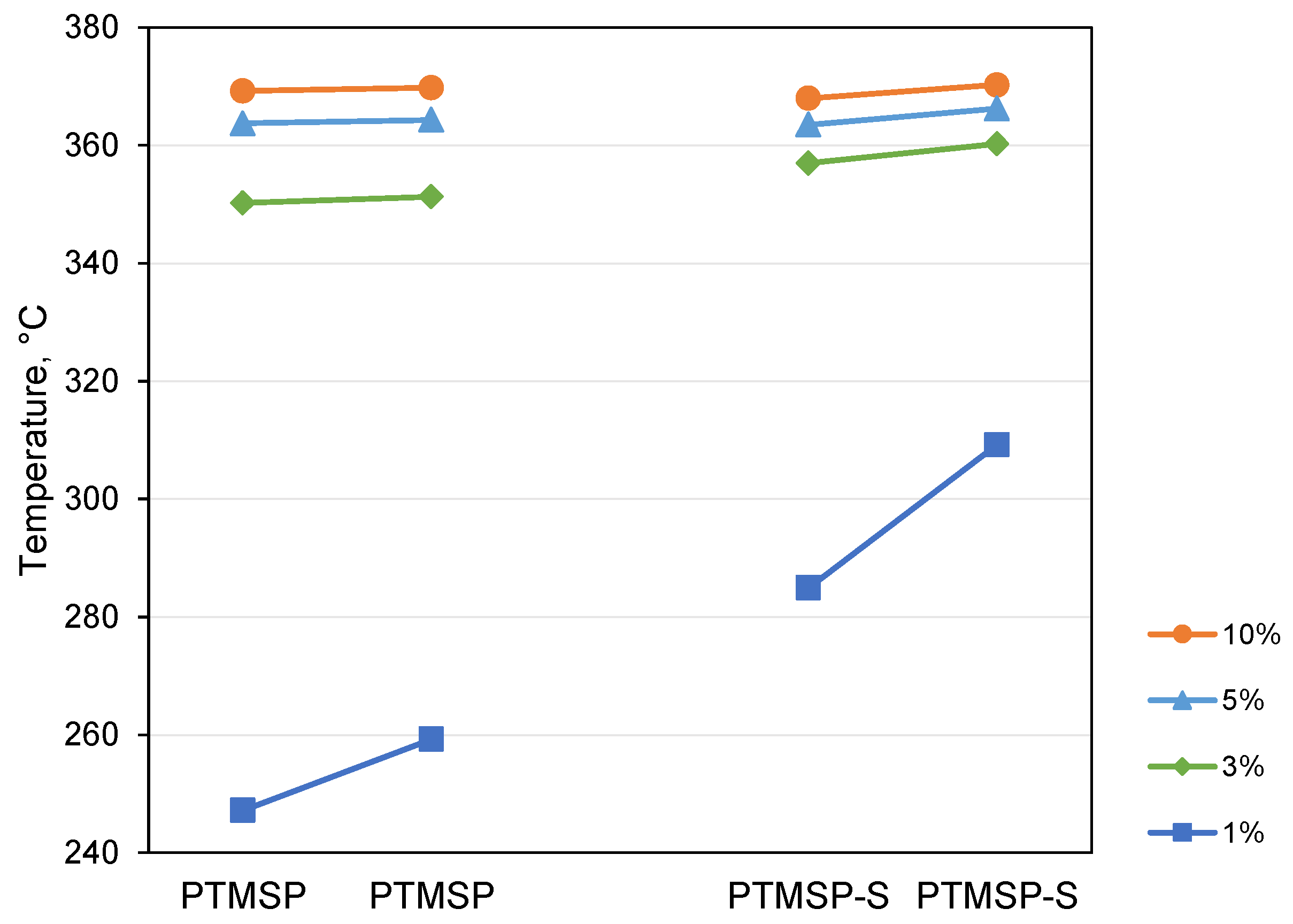
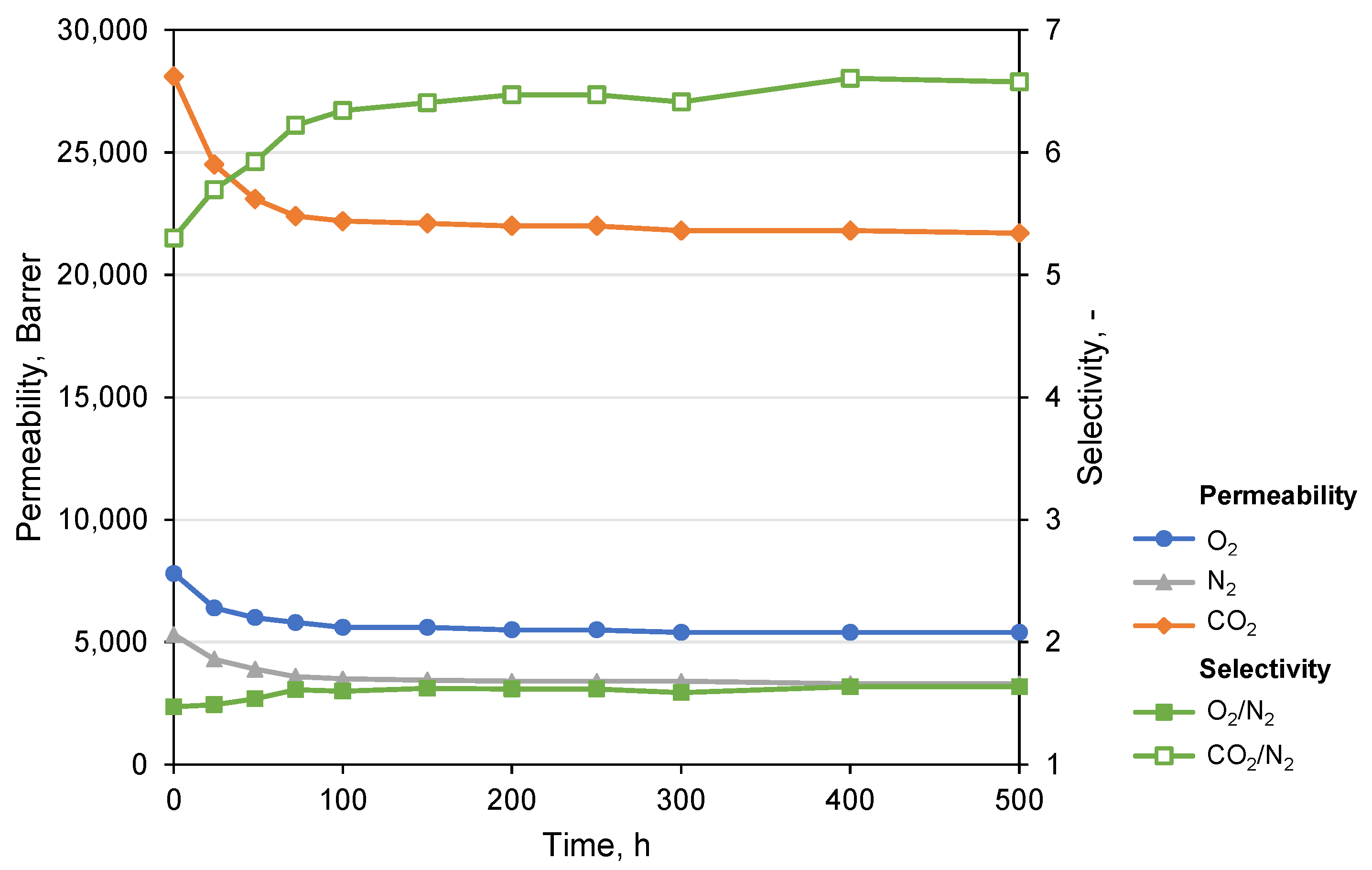
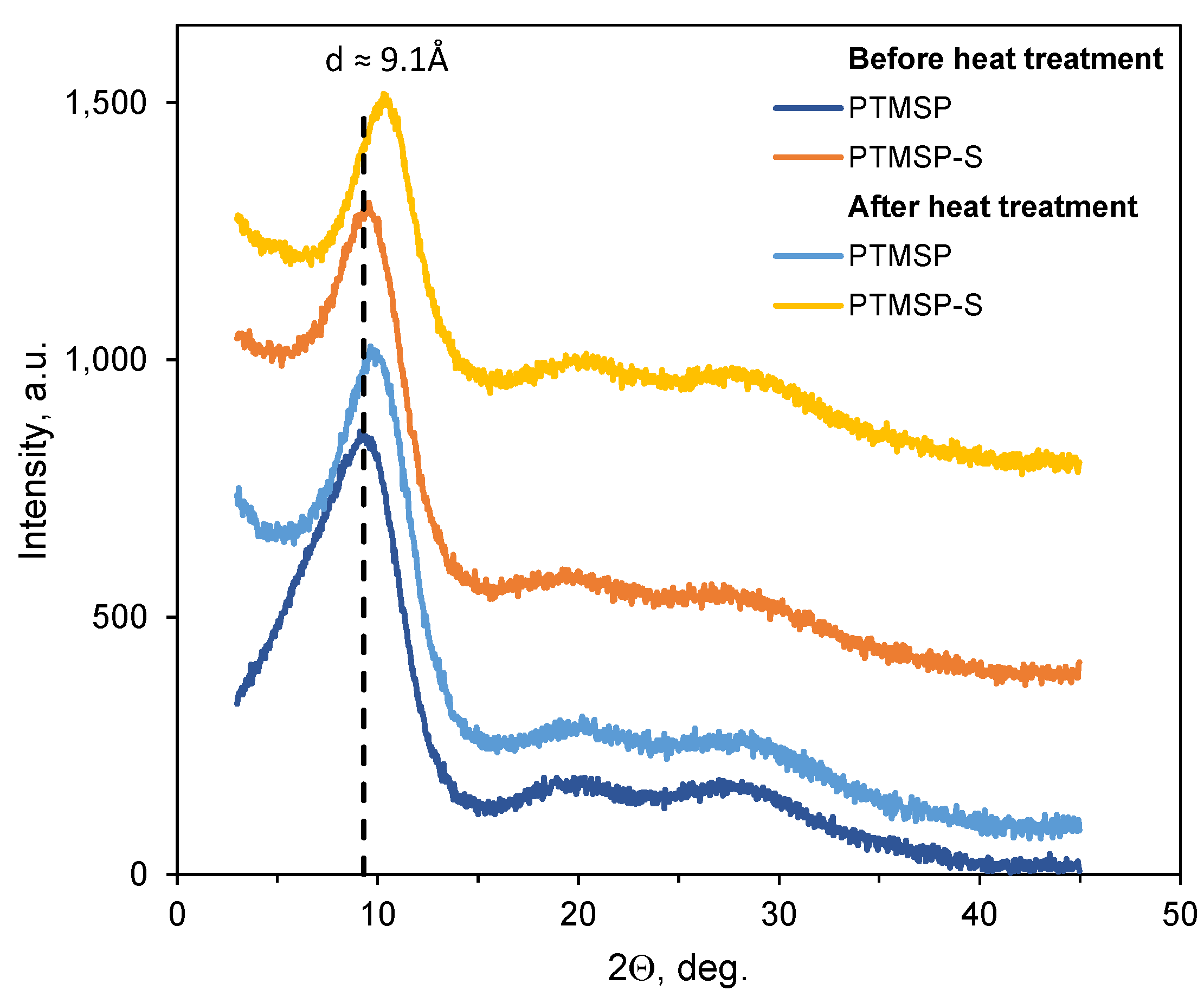
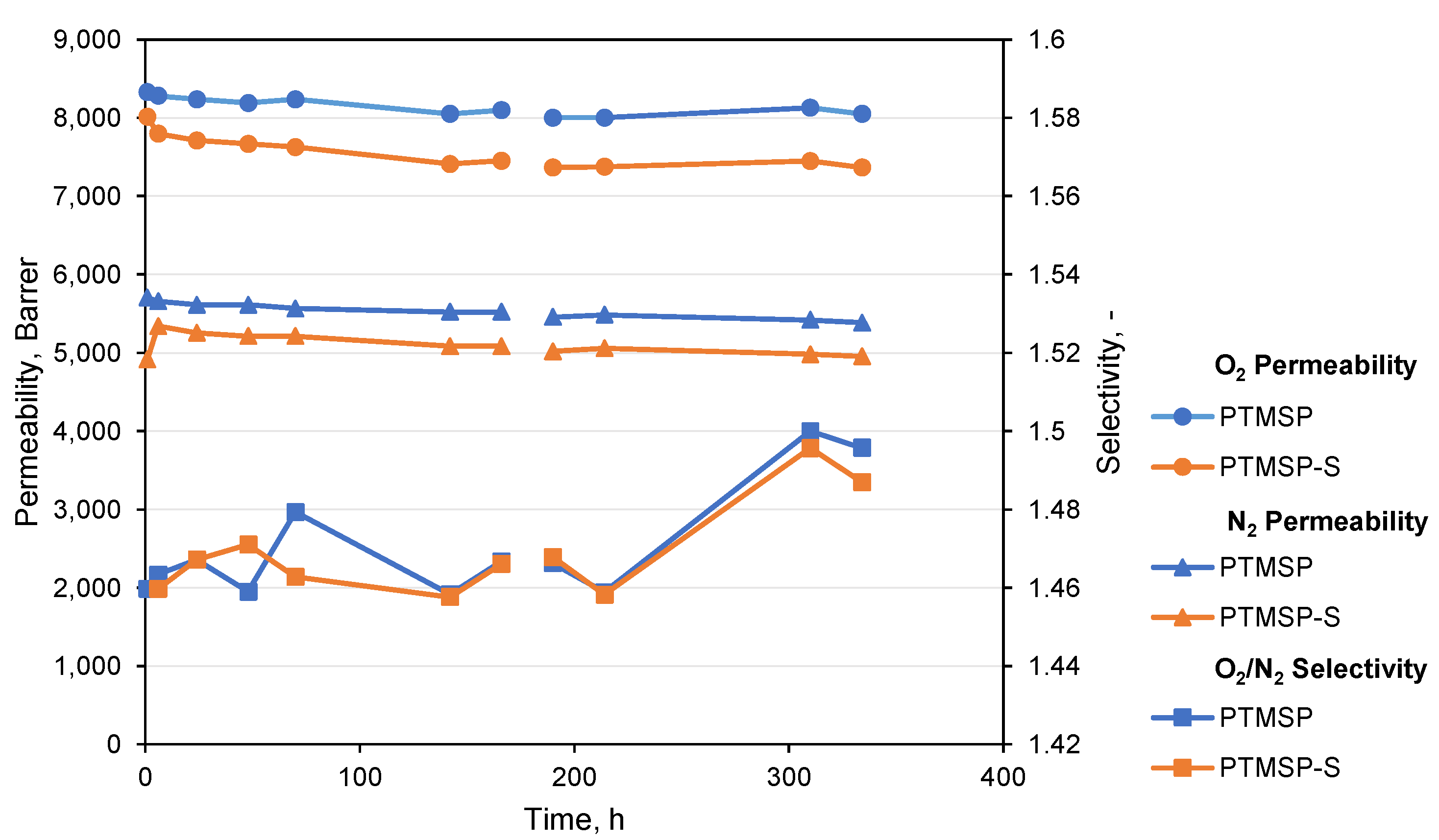
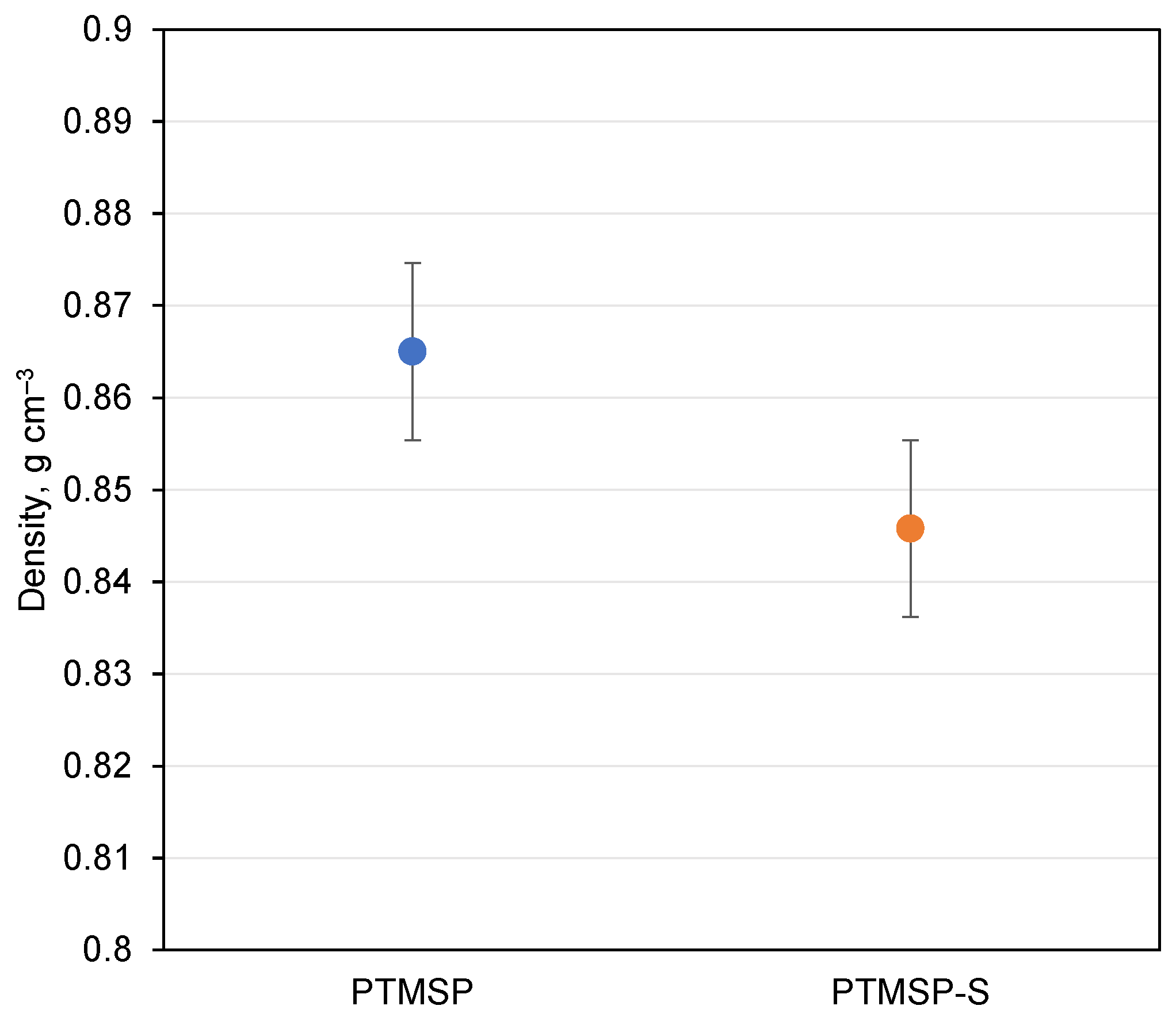
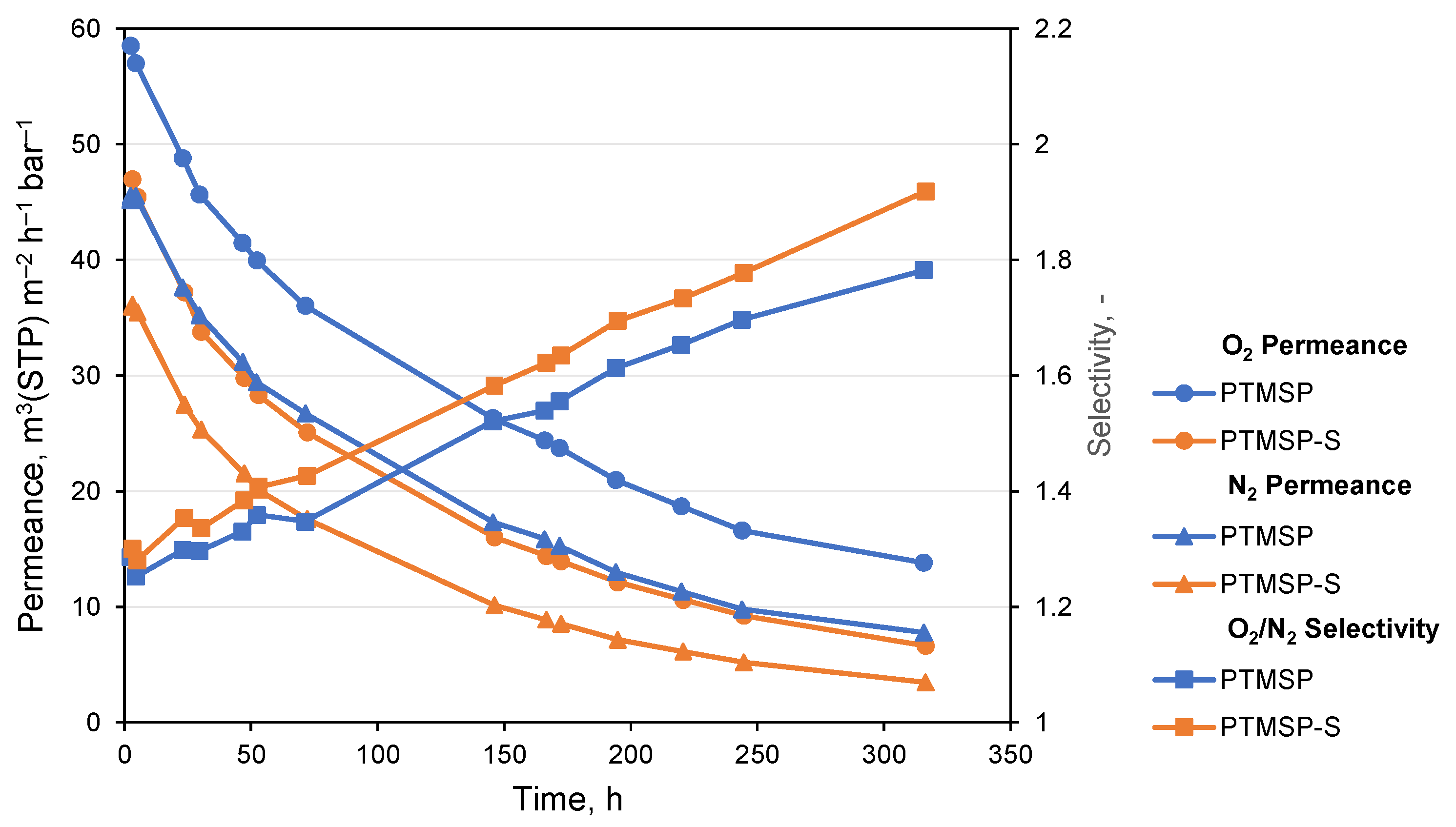
| Sample | Permeability Coefficient, P (Barrer) 1 | Ideal Selectivity, α | |||
|---|---|---|---|---|---|
| O2 | N2 | CO2 | O2/N2 | CO2/N2 | |
| PTMSP 2 | 8400 | 5600 | 30,200 | 1.5 | 5.4 |
| PTMSP 3 | 8300 | 5800 | - | 2.4 | - |
| PTMSP-S 2 | 7800 | 5300 | 28,100 | 1.5 | 5.3 |
| PTMSP-S 3 | 8000 | 4900 | - | 1.6 | - |
| Sample | Total Time of Heat Treatment, h | Permeability Coefficient, P (Barrer) | Ideal Selectivity, α | |||
|---|---|---|---|---|---|---|
| O2 | N2 | CO2 | O2/N2 | CO2/N2 | ||
| PTMSP | 24 | 7100 | 3700 | 22,000 | 1.9 | 5.9 |
| 48 | 10,500 | 8000 | 27,200 | 1.3 | 3.4 | |
| 72 1 | - | - | - | - | - | |
| PTMSP-S | 24 | 6400 | 4300 | 24,500 | 1.5 | 5.7 |
| 48 | 6000 | 3900 | 23,100 | 1.5 | 5.9 | |
| 72 | 5800 | 3600 | 22,400 | 1.6 | 6.2 | |
| Sample | 2θ, ° | Δ1/2, ° | Interchain Distance d, Å |
|---|---|---|---|
| PTMSP (before heat treatment) | 9.6 | 3.69 | 9.26 |
| PTMSP (after heat treatment) | 9.7 | 3.11 | 8.87 |
| PTMSP-S (before heat treatment) | 9.7 | 3.56 | 9.13 |
| PTMSP-S (after heat treatment) | 10.5 | 3.24 | 8.44 |
Publisher’s Note: MDPI stays neutral with regard to jurisdictional claims in published maps and institutional affiliations. |
© 2022 by the authors. Licensee MDPI, Basel, Switzerland. This article is an open access article distributed under the terms and conditions of the Creative Commons Attribution (CC BY) license (https://creativecommons.org/licenses/by/4.0/).
Share and Cite
Shishatskiy, S.; Makrushin, V.; Levin, I.; Merten, P.; Matson, S.; Khotimskiy, V. Effect of Immobilization of Phenolic Antioxidant on Thermo-Oxidative Stability and Aging of Poly(1-trimethylsilyl-1-propyne) in View of Membrane Application. Polymers 2022, 14, 462. https://doi.org/10.3390/polym14030462
Shishatskiy S, Makrushin V, Levin I, Merten P, Matson S, Khotimskiy V. Effect of Immobilization of Phenolic Antioxidant on Thermo-Oxidative Stability and Aging of Poly(1-trimethylsilyl-1-propyne) in View of Membrane Application. Polymers. 2022; 14(3):462. https://doi.org/10.3390/polym14030462
Chicago/Turabian StyleShishatskiy, Sergey, Vladimir Makrushin, Ivan Levin, Petra Merten, Samira Matson, and Valeriy Khotimskiy. 2022. "Effect of Immobilization of Phenolic Antioxidant on Thermo-Oxidative Stability and Aging of Poly(1-trimethylsilyl-1-propyne) in View of Membrane Application" Polymers 14, no. 3: 462. https://doi.org/10.3390/polym14030462
APA StyleShishatskiy, S., Makrushin, V., Levin, I., Merten, P., Matson, S., & Khotimskiy, V. (2022). Effect of Immobilization of Phenolic Antioxidant on Thermo-Oxidative Stability and Aging of Poly(1-trimethylsilyl-1-propyne) in View of Membrane Application. Polymers, 14(3), 462. https://doi.org/10.3390/polym14030462







